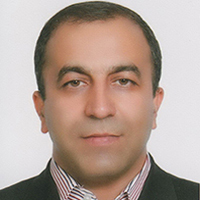Long-term Effects of Different Irrigation Methods with Treated Wastewater on Soil Chemical Properties
Author(s):
Abstract:
Introduction
Reuse of wastewater for agricultural irrigation is increasing due to an increased demand for water resources in different parts of the world. Almost 70% of deviated water from rivers and pumped groundwater is used for agriculture. If wastewater is used for irrigation in agriculture, then the amount of discharged water from natural sources will be decreased and the flow of wastewater to the environment and its ensuing pollution will be prevented. Using wastewater in applications such as irrigation of agricultural lands has caused an increase of some exchangeable ions, salts and suspended solids (organic and mineral) in the soil and has significantly affected physical, chemical and biological features. Therefore, paying attention to the soil health is important during use of wastewater when it is the source of irrigation water. In such cases, there will be some worries about pollution of harvested products, contact of farm workers with pathogenes and environmental issues in the farm. In these conditions, attention to irrigation methods along with consideration of environmental protection standards is important. Materials And Methods
In this study, the effects of treated wastewater (TW) irrigation were tested on some chemical properties of soil for three years under five different irrigation treatments. The treatments were as follows: surface furrow irrigation (FI), surface drip irrigation (SDI), subsurface drip irrigation in 30 cm depth (SDI30), subsurface drip irrigation in 60 cm depth (SDI60) and bubbler irrigation (BI). At the end of the experiment, soil samples were collected from a depth of 0-30, 30-60 and 60-90 cm in order to measure the electrical conductivity (EC), pH, sodium adsorption ratio (SAR), organic matter (OM) and calcium carbonate equivalent (CaCO3). Results And Discussion
According to the results of soil analysis, the soil became more saline than the beginning by applying the treatments. Generally, in two plots of urban and industrial wastewater, the least salinity was observed in SDI (19.0% increase in salinity) and the maximum value of these parameters was observed in BI (99.7% increase in salinity). The results showed that average SAR in soil saturation extract of three layers were 5.5 and 6.6 dS m-1, respectively for urban and industrial plots. Considering these values along with EC, the soil will be categoraized as normal soil in terms of salinity and alkalinity. An increase of 14.3 % in BI and 8.2% in SID30 were observed in comparison with the initial values of the period. These were the extremums for SAR. The results also showed that the application of TW caused a 38.75 % reduction in SAR for the 30-60 cm. Soil pH of the plots under study was decreased significantly and reached its acceptable limit in the soil during the experiment. On the average, the pH of soil layer has been 7.4 and 7.3 for urban and industrial plots, respectively. The results showed that soil organic matter was influenced by the irrigation method and this was more pronounced in the location of wastewater injection. In the soil surface, the highest amount of organic matter was observed in treatment FI and SDI. However, in a depth of 30-60 and 60-90, SDI30 and SDI60 revealed the highest amount of organic matter content. The average concentration of chloride (Cl-) ions in industrial wastewater (12.3 meq L-1) was more than that of urban wastewater (7.3 meq L-1). Therefore, the effect of industrial wastewater on increasing soil Cl- has been more pronounced than that of urban wastewater. Soil Cl- was increased at the location of wastewater injection and the highest amount of Cl- in the irrigation treatments was observed in BI. The results also showed that the application of TW caused a 23.4% reduction in soil CaCO3 content at a depth of 60-90 cm. The lowest amount of CaCO3 was recorded in treatment SDI60. There was no significant difference between the average of irrigation treatments in the urban plots. But in the last layer, it showed that SDI30 had a significant difference with both SDI and SDI60, in the industrial plots. Conclusion
Generally, SDI irrigation in the root zone depth (in this study was up to 60 cm) is recommended for protecting safe environmental conditions, supplying water demand in the root zone and improving soil quality.Language:
Persian
Published:
Journal of water and soil, Volume:29 Issue: 1, 2015
Pages:
12 to 22
magiran.com/p1426281
دانلود و مطالعه متن این مقاله با یکی از روشهای زیر امکان پذیر است:
اشتراک شخصی
با عضویت و پرداخت آنلاین حق اشتراک یکساله به مبلغ 1,390,000ريال میتوانید 70 عنوان مطلب دانلود کنید!
اشتراک سازمانی
به کتابخانه دانشگاه یا محل کار خود پیشنهاد کنید تا اشتراک سازمانی این پایگاه را برای دسترسی نامحدود همه کاربران به متن مطالب تهیه نمایند!
توجه!
- حق عضویت دریافتی صرف حمایت از نشریات عضو و نگهداری، تکمیل و توسعه مگیران میشود.
- پرداخت حق اشتراک و دانلود مقالات اجازه بازنشر آن در سایر رسانههای چاپی و دیجیتال را به کاربر نمیدهد.
دسترسی سراسری کاربران دانشگاه پیام نور!
اعضای هیئت علمی و دانشجویان دانشگاه پیام نور در سراسر کشور، در صورت ثبت نام با ایمیل دانشگاهی، تا پایان فروردین ماه 1403 به مقالات سایت دسترسی خواهند داشت!
In order to view content subscription is required
Personal subscription
Subscribe magiran.com for 70 € euros via PayPal and download 70 articles during a year.
Organization subscription
Please contact us to subscribe your university or library for unlimited access!



